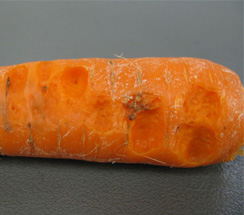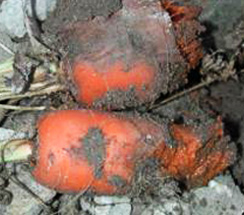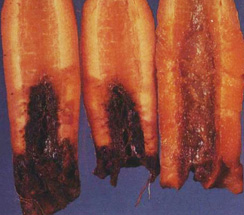| Bacterial soft rot: Erwinia carotovora sub sp. caotovora |
Symptom:
- Cells become water soaked, middle lamella is destroyed and the cells collapse
- Soft, watery or slimy consistency
- Rotted tissues – grey to brown, accompanied by foul odour
- In the field, tops of rotted carrots turn yellow and wilt as roots break down
|
| |
 |
 |
 |
| |
Soft watery carrot |
Rotted tissue |
Cross section of internal tissue |
|
Identification of pathogen:
- Bacteria is gram –ve, motile with large peritrichous flagella
Mode of spread and survival:
- Soil - source of primary inoculum
- Survive in decaying refuse and enter the root principally through cultivation wounds, harvest bruises, freezing injury, and insect openings
- Flies – Hylemus cillicrura, H. brassicae – carry the bacteria in their intestinal tracts
|
Management:
- Careful handling at harvest - minimizes bruising of carrot roots
- Washing - dipping in a solution of sodium hypochlorite (5.25%)
- Storage condition - temp- just above freezing(0ºC), RH 90 %
- Crop rotation - alfalfa, beans, beets, corn
|
Source of Images:
http://mtvernon.wsu.edu/path_team/DiseaseGallery/carrot-bacterial-soft-rot-5.htm
http://www.infonet-biovision.org/res/res/files/2122.280x185.clip.jpeg
http://phytopath.ca/wp-content/uploads/2015/03/DPVCC-colour-plates-chapter-6-carrot.pdf
|



